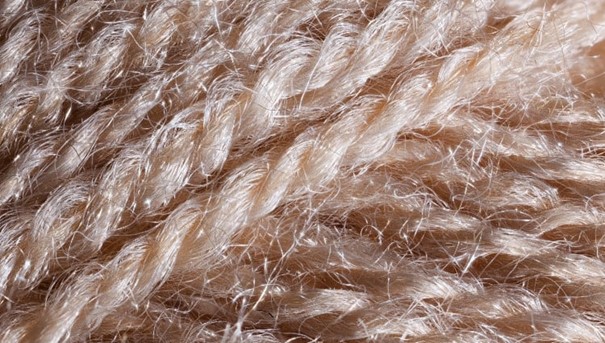
Acrylic fibres, which are derived from polyacrylonitrile, a synthetic organic polymer [1], experienced their most significant expansion in the clothing industry during the 1950s, challenging the traditional dominance of wool in knitted sweaters [2]. Acrylic’s popularity soared due to its warmth and wool-like texture, often chosen as an affordable substitute for cashmere wool, finding applications in various clothing and home furnishings [1]. It frequently partners with wool due to their similar properties [7]. Beyond this, acrylic can be spun to mimic other fibres like cotton and is even used to create faux fur [3]. Although acrylic fibres can sometimes become frayed or develop a nubby texture, it’s worth noting that some variants exhibit this to a lesser degree.
Photo: Silver Bobbin
China is the world’s primary acrylic producer, contributing over 30% of the global acrylic production [8]. The production process begins with the creation of acrylonitrile, achieved through the reaction of petroleum or carbon-based chemicals with various monomers, constituting a polymer’s fundamental building blocks. Consequently, acrylic finds its roots in fossil fuels.
Acrylic is produced by forcing acrylonitrile to react with various chemical processing agents [4]. Following this, it undergoes spinning into a molten state and then a hot water wash to remove any remaining solutions and salts. The fibres are subsequently placed in tanks at boiling temperatures to impart strength. They are then subjected to an acid bath to acquire antistatic properties before final drying.
To be officially categorized as actual acrylic, a fabric must contain at least 85% acrylonitrile [8]. Three other acrylic types exist based on different polymers apart from acrylonitrile [9]. Fashion acrylic predominantly applies in sportswear, while Lastrile stands out for its enhanced elasticity. Although less popular, Nitrile is notable for its limited colour retention capabilities.
Photo: Silver Bobbin
The production of acrylic uses toxic substances that require cautious handling [1]. Acrylic fibre’s storage, disposal and polymerization process releases poisonous gases that are hazardous to human health. Acrylonitrile is a so-called VOC (Volatile Organic Compound) that can create harmful ground-level ozone, which is toxic to plants [8]. However, it is unclear how much acrylic production affects the creation of ground-level ozone. In addition to being harmful to the environment, acrylics can affect human health [8]. As early as 1979, the US Environmental Protection Agency became concerned that residues in acrylic fabrics may be carcinogenic. They use flame retardants on acrylic to prevent its high flammability despite their potential toxicity.
Acrylic production and its environmental impact require further scientific investigation [4],[7]. It’s well-established that various chemicals in the production process, along with the primary ingredient acrylonitrile, have the potential to pose environmental challenges if released directly into the environment [4].
However, a 2012 study comparing different textiles’ environmental impact and ecological sustainability highlighted acrylic as having the poorest ecological sustainability and most significant adverse environmental effects [5]. Additionally, it’s worth noting that acrylic production is energy-intensive, exceeding even the energy requirements of polyester production by 30% [4]. Moreover, acrylic consumes a greater volume of water than polyester. For instance, producing 1 kg of acrylic requires approximately 157-194 MJ of energy, 210 litres of water, and the emission of roughly 5 kg of carbon dioxide [1].
Photo: Silver Bobbin
Acrylic is not biodegradable and is challenging to recycle [1]. Therefore, there is no practical method of removing acrylic clothing once it is produced [8]. One study estimated that a 6 kg wash of acrylic fabric released just over 700 000 microfibers compared to polyester, which released 496 030 microfibers [6]. Microfibers are one of several sources of microplastics, which have become an increasing problem for freshwater and marine ecosystems where they accumulate. Acrylic is seldom found in products bearing eco-labels primarily due to the use of problematic chemicals in its production (7). Another contributing factor is its synthetic nature [8].
Sources
- Elsevier.com – Assessing the Environmental Impact of Textiles and the Clothing Supply Chain

- ScienceDirect – Handbook of Properties of Textile and Technical Fibres – Polyacrylonitrile fibers

- Wikipedia – Acrylic fibre

- Kate Fletcher – Sustainable Fashion and Textiles: Design Journeys

- Sciencedirect – Quantification of environmental impact and ecological sustainability for textile fibres

- Sciencedirect – Release of synthetic microplastic plastic fibres from domestic washing machines – Effects of fabric type and washing conditions

- Eco-stylist – A Guide to the Most and Least Sustainable Fabrics

- Sewport – What is Acrylic Fabric: Properties, How its Made and Where

- Silver Bobbin – What is Acrylic Fabric? The Only Guide You Will EVER Need

October 2023 RETHINK | Revised May 2024






